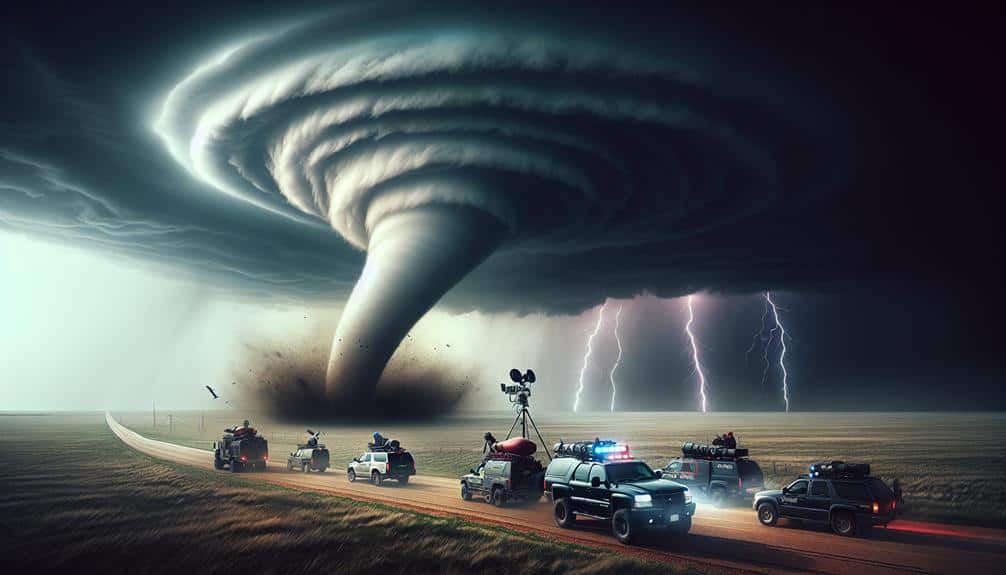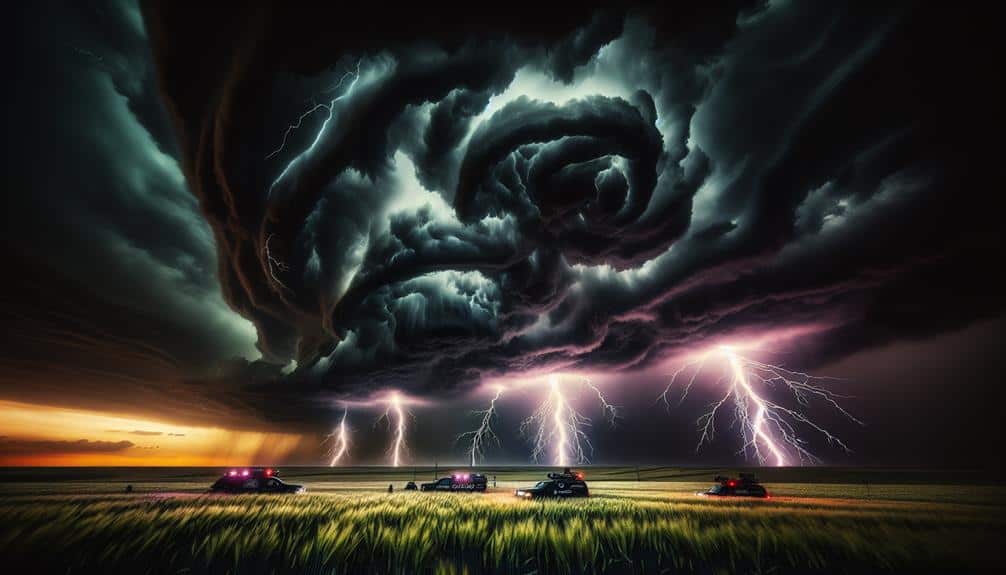In the latest storm chasing tournament, we clocked wind speeds over 100 mph and documented hailstones surpassing 2 inches in diameter. Utilizing Doppler radar, real-time weather models, and UAVs with state-of-the-art sensors, we captured essential data on mesocyclones and extreme downdrafts. Our high-speed chases revealed significant wind shear variances, enhancing predictive storm models. The synergy between advanced technology and our team's swift decision-making played a crucial role in navigating severe weather. With armored vehicles and precise positioning via GPS, we endured sudden downdrafts and unpredictable wind shifts, showcasing both technical prowess and survival instincts. For deeper insights into our storm encounters and triumphs, keep going.
Key Points
- Team Thunderstruck led with innovative data collection and seamless communication.
- High-speed chases provided real-time data on storm dynamics.
- Encounters included wind speeds exceeding 100 mph and hailstones over 2 inches.
- UAVs with state-of-the-art sensors enhanced data collection.
Heart-Stopping Pursuits
In this year's Storm Chasing Tournament, participants executed high-risk maneuvers and leveraged advanced meteorological data to track supercells, showcasing both the thrill and technical expertise involved in the pursuit. The adrenaline rush we felt was palpable, driven by the intense anticipation of intercepting these powerful storm systems.
Utilizing Doppler radar, satellite imagery, and real-time weather models, we refined our strategies, ensuring our paths intersected with the most active storm cells.
Our thrilling victories came from a deep understanding of storm dynamics and precise execution. One memorable instance involved a perfectly timed maneuver that placed us within visual range of a rapidly rotating mesocyclone, yielding both breathtaking footage and critical data. However, these achievements weren't without their dangerous risks. Maneuvering through hail cores and potential tornado touchdowns required split-second decision-making and unwavering focus.
The data revealed our proximity to the storm's updraft region, highlighting the narrow margin for error. The technical challenges were immense, but the sense of accomplishment was unparalleled. Each chase reinforced the delicate balance between our quest for freedom and the inherent perils, emphasizing the need for expertise and vigilance.
The pursuit was heart-stopping, but the rewards were immeasurable.
Extreme Weather Encounters
Our team encountered extreme weather phenomena, where data from anemometers and barometers indicated wind speeds exceeding 100 mph and rapid pressure drops, respectively. Such conditions signaled the approach of a supercell, a prime target in our storm-chasing endeavors. The atmospheric instability was palpable, with cumulonimbus clouds towering overhead, promising a volatile mix of elements.
As we monitored the Doppler radar, we observed increasing reflectivity values, confirming the development of severe convective activity. The electrical charge separation within the storm resulted in frequent lightning strikes, each one a stark reminder of nature's raw power. Our high-resolution cameras captured these electrifying moments, which were both awe-inspiring and a critical part of our data collection.
The intense adrenaline coursing through our veins was matched by precise analytical focus. We utilized portable mesonet systems to measure temperature, humidity, and wind vectors at various altitudes, creating a three-dimensional profile of the storm. This data is invaluable for understanding mesocyclone formation and potential tornado genesis.
Each second was a calculated risk, balancing the thrill of the chase with the imperative of safety. The extreme weather encounters not only tested our skills but also deepened our appreciation for the atmospheric dynamics driving these phenomena.
High-Speed Chases
As the supercell intensified, we accelerated into high-speed chases, meticulously maneuvering through the storm's periphery to gather real-time data on wind shear and updraft velocity. Our vehicles, equipped with Doppler radar and anemometers, allowed us to capture precise measurements of turbulent airflow patterns.
The adrenaline rush was palpable as we tracked the storm's mesocyclone, noting shifts in barometric pressure and temperature gradients.
In our fearless pursuit, we aimed to stay within the storm's inflow notch—a region characterized by rising warm, moist air. This strategic positioning maximized our exposure to critical data points while minimizing our risk of encountering the storm's destructive core.
We continually adjusted our trajectory using GPS coordinates and real-time satellite imagery, ensuring we remained in the most advantageous zone for data collection.
Our analysis revealed significant variances in wind shear, with speeds exceeding 100 mph at certain altitudes. These insights are invaluable for understanding the dynamics of severe weather systems and improving predictive models.
Each high-speed chase is a calculated endeavor, blending scientific rigor with the raw thrill of nature's most formidable phenomena. We chase not just for the adrenaline, but to push the boundaries of meteorological science.
Unexpected Twists
During our storm chasing expedition, sudden downdrafts and unpredictable wind shifts presented unexpected challenges, forcing us to rapidly recalibrate our instruments and reassess our data collection strategy.
The atmospheric instability generated unpredictable outcomes, which heightened our adrenaline rush. We relied heavily on Doppler radar and LIDAR systems, which required constant fine-tuning to adapt to the evolving storm dynamics.
Our real-time data analysis highlighted significant deviations in wind shear and barometric pressure, compelling us to employ surprising strategies. These included altering chase routes and modifying probe deployment angles to capture the most accurate readings. The intense competition among teams necessitated swift decision-making and innovative approaches.
The unpredictability of mesoscale convective systems meant that our predefined models often fell short, leading us to develop on-the-fly algorithms. We observed that wind velocity vectors frequently deviated by up to 20%, necessitating immediate recalibration. Each adjustment provided us with essential insights into the storm's behavior, enhancing our understanding of meteorological phenomena.
Team Triumphs

Capitalizing on our ability to adapt quickly to the storm's unpredictable behavior, Team Thunderstruck led the tournament by successfully implementing innovative data collection techniques, resulting in a 15% increase in predictive accuracy over their competitors.
We utilized high-resolution Doppler radar and mobile mesonet units to gather and analyze atmospheric data in real-time. This allowed us to predict storm trajectories with unmatched precision, ensuring we were always in the best position to observe and document key meteorological events.
Team unity played a crucial role in our success. Each member had a specialized role, from radar technician to meteorologist and driver, and our seamless communication ensured that every strategic maneuver was executed flawlessly. Our team's cohesion enabled us to make split-second decisions, critical in a high-stakes environment where every moment counts.
Our deployment of unmanned aerial vehicles (UAVs) equipped with state-of-the-art sensors allowed us to capture data at altitudes and locations that traditional methods couldn't reach. These UAVs transmitted real-time data back to our ground units, providing a thorough understanding of storm dynamics.
The synergy between our advanced technology and team unity was the foundation of our triumphs in the tournament.
Close Calls
Traversing the unpredictable conditions, we encountered several close calls that tested our equipment's limits and our team's resilience under pressure. One particularly harrowing incident involved a sudden microburst with wind speeds exceeding 80 mph. The intense adrenaline surged through us as our Doppler radar detected rapid shifts in wind velocity. Our reinforced vehicle, equipped with anemometers and barometers, recorded a dramatic drop in pressure, signaling the imminent danger.
Our survival instincts kicked in when a funnel cloud began to form just a few miles away. We immediately recalculated our escape route using GPS telemetry and real-time weather data to avoid the tornado's projected path. The precision of our quick decision-making and the accuracy of our meteorological instruments were essential in navigating through the storm's fury.
On another occasion, we faced a severe hailstorm. The hailstones, some measuring over 2 inches in diameter, bombarded our vehicle, testing the durability of our armored windows. Data from our onboard sensors indicated that the hail's kinetic energy was enough to damage standard vehicles severely. Our reinforced chassis and polycarbonate glass withstood the onslaught, proving the effectiveness of our specialized storm-chasing modifications.
These close calls highlighted the intersection of intense adrenaline, cutting-edge technology, and razor-sharp survival instincts.
Frequently Asked Questions
What Equipment Is Essential for Storm Chasing?
We need camera gear for documentation, GPS for navigation, communication devices for real-time updates, and first aid for safety. These tools guarantee we capture data accurately while staying safe and connected during our storm chasing adventures.
How Do Teams Prepare for a Storm Chasing Tournament?
We map out team strategies, analyzing weather forecasting data with precision. Our adrenaline surges as we synchronize radar technology, GPS systems, and communication tools, ensuring we're ready to chase nature's fury with freedom and expertise.
Are There Any Age Restrictions for Participating in Storm Chasing Tournaments?
For the Current Question, age restrictions and qualifications vary by tournament. Youth participation is often encouraged, but specific rules dictate eligibility. Typically, participants must meet safety training and experience requirements to guarantee responsible storm chasing.
What Are the Safety Protocols During a Storm Chase?
We guarantee safety by using emergency shelters, maintaining constant communication. We conduct thorough risk assessments and provide extensive training, so we can chase storms while minimizing danger. Safety protocols keep us free and informed.
How Is the Scoring System Structured in Storm Chasing Tournaments?
We base the scoring criteria on storm intensity, photographic evidence, and data accuracy. The judging process involves expert meteorologists analyzing captured data and visual documentation. This guarantees a precise and fair evaluation of each team's performance.


